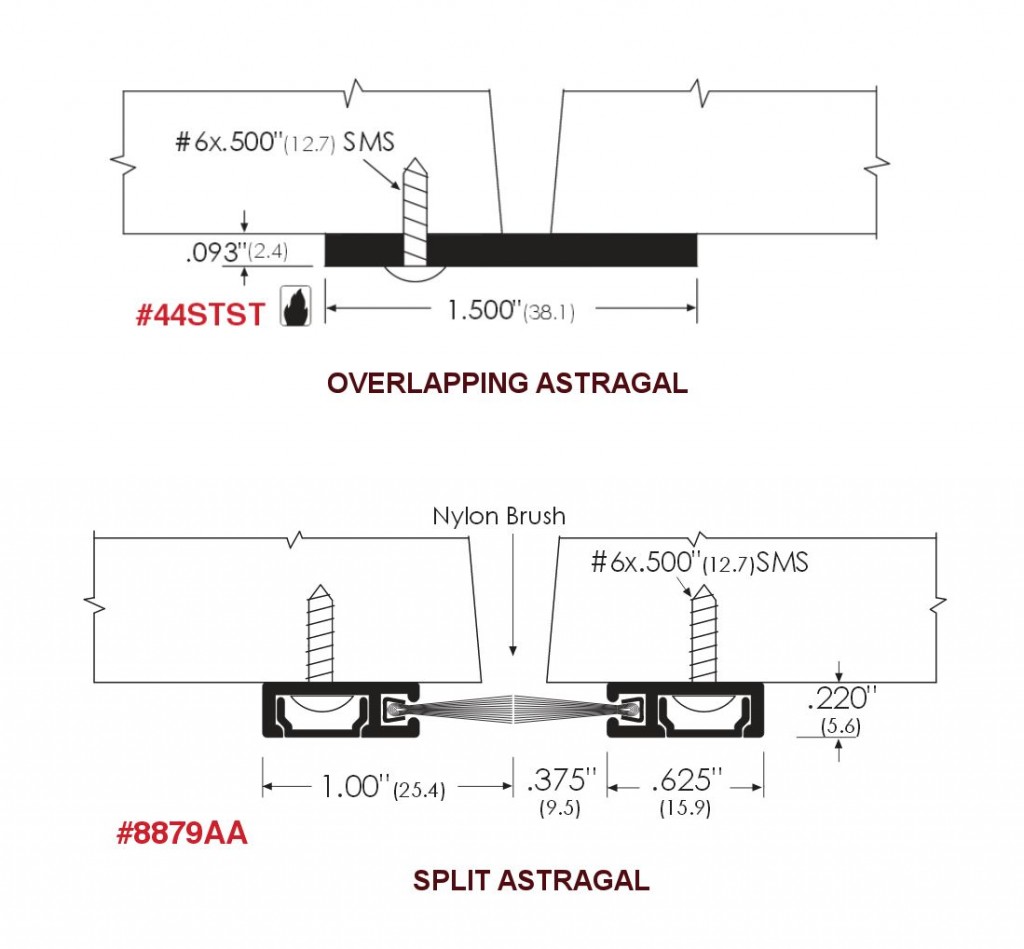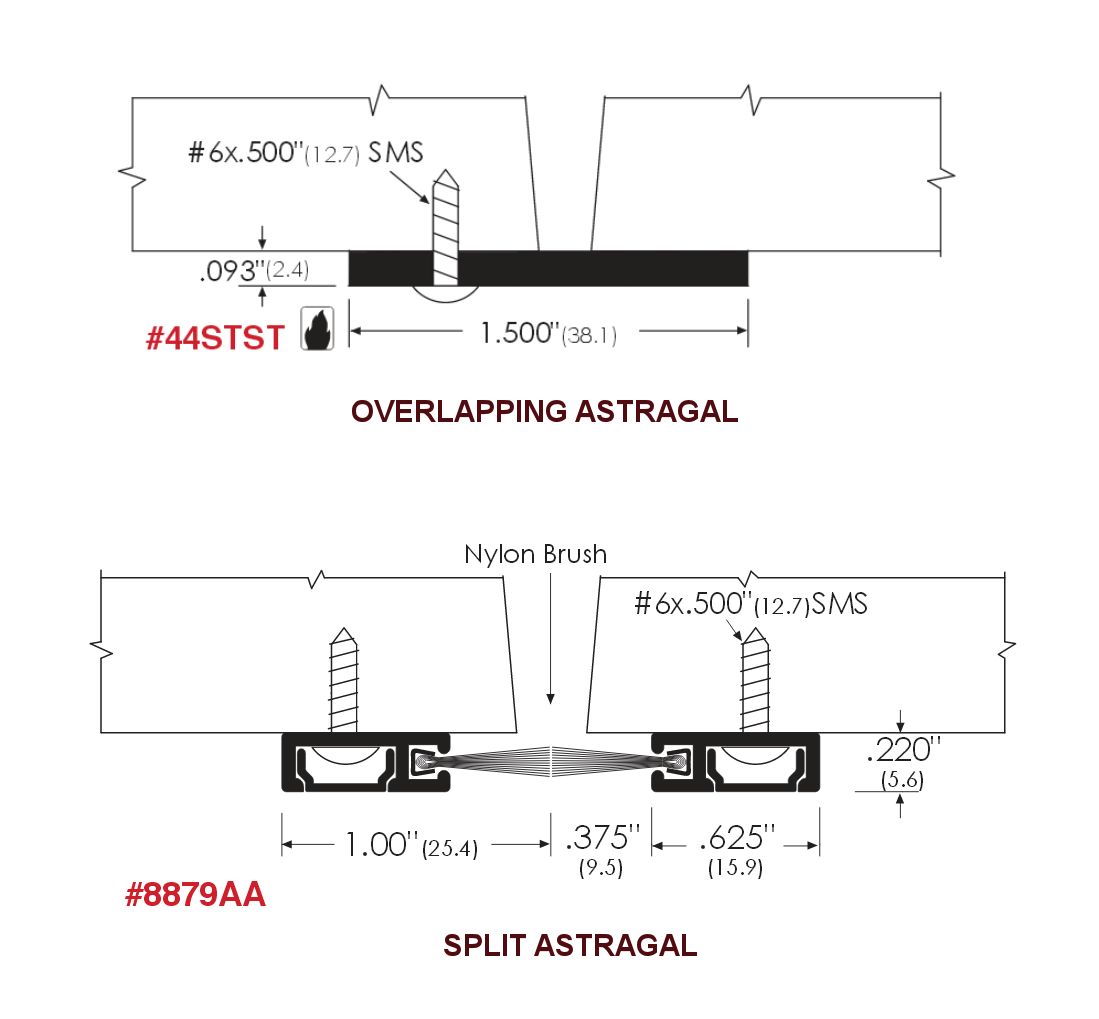NFPA 80 – Standard for Fire Doors & Other Opening Protectives no longer includes a prescriptive requirement for certain pairs of fire doors to have astragals. In the 1999 edition of this standard (and prior editions), an overlapping astragal was required for pairs of doors rated for more than 1 1/2 hours. In the 2007 edition, the requirement for an overlapping astragal was removed, and the use of the astragal is dependent on the manufacturer’s listing procedures. If a jurisdiction has adopted a code which references the 2007 edition of NFPA 80 or a later edition, check with your door manufacturer to see if an astragal is required.
 When an overlapping astragal is used, pairs typically have either automatic flush bolts and a lockset, or mortise fire exit hardware on one leaf and vertical rod fire exit hardware on the other. These applications also require a coordinator to ensure that the doors close in the proper sequence. The reason the mortise x vertical rod application was commonly used on 3-hour pairs was to avoid the overlapping astragal causing an egress restriction. If two vertical rod devices are used with an overlapping astragal, one door would not be available for egress unless the other door was opened first. NFPA 80 prohibits egress doors from having an overlapping astragal that restricts the free use of either leaf.
When an overlapping astragal is used, pairs typically have either automatic flush bolts and a lockset, or mortise fire exit hardware on one leaf and vertical rod fire exit hardware on the other. These applications also require a coordinator to ensure that the doors close in the proper sequence. The reason the mortise x vertical rod application was commonly used on 3-hour pairs was to avoid the overlapping astragal causing an egress restriction. If two vertical rod devices are used with an overlapping astragal, one door would not be available for egress unless the other door was opened first. NFPA 80 prohibits egress doors from having an overlapping astragal that restricts the free use of either leaf.
NFPA 80 defines two types of astragals – overlapping astragals and split astragals. Split astragals are also called meeting stile gasketing. NFPA 80 states that pairs of doors which require astragals must have at least one attached in place which projects approximately 3/4-inch, but this is dependent upon the manufacturer’s listings. Many door manufacturers do not require astragals for most of their fire-rated pairs, although gasketing may be required at the meeting stiles to reduce air/smoke infiltration. Astragals or meeting stile gasketing may also be used for other purposes, such as weather, sound, or light.
Graphics: Zero International
You need to login or register to bookmark/favorite this content.






Man, that is confusing. So it looks like they are leaving it up to the mfg. of the doors? That makes zero sense. What about smoke? Do they need one for smoke? It would seem to make more sense to say if the gap is over “blank” then one is required; period. We do a lot of DoD jobs and in every instance of double fire doors they have split astragals. Does this mean they don’t have to have them? Can you address the smoke requirement. It seems to have all but replaced the fire requirements. THANKS,
Yes, whether or not the door will need an astragal to maintain the fire rating will be up to the manufacturer. It will depend on how they successfully tested the doors. For smoke, it depends on whether the adopted building code requires doors in that location to limit air/smoke infiltration. The link that I included in today’s post (http://idighardware.com/2015/11/decoded-smoke-door-requirements-of-the-2015-international-building-code/) leads to an article about smoke gasketing and other requirements for smoke doors.
– Lori
Does the max 1/8″ gap (+ 1/16 on wood doors) at top and sides of a single door not apply between double doors?
Hi Nelson –
The max clearance at the head, jambs, AND meeting stiles is 1/8″ for wood fire doors and 3/16″ for hollow metal fire doors.
– Lori
Lori
As a wood door manufacturer it seems counter intuitive to apply an astragal that caps off the edge of a positive pressure intumescent edged door. Wouldn’t the metal astragal prohibit the intumescent from expanding and sealing the gap?
Yes – I think an overlapping astragal can cause problems with intumescent material in the door edge.
– Lori
Hello if I have a fire pair of doors an I put a brush Astragal on there does the gap matter? If so can I put a brush on both sides to eliminate my problems
The use of an astragal does not change the allowable gap. Some manufacturers now offer products listed for filling oversized gaps.
But the general rule is 1/8” for wood and 3/16” for metal due to thermal expansion.
What would be best practice for astragal placement on Double Egress fire door pairs. Would opposite doors with astragals on the pull sides be correct?
Yes, that is typical, although I’m not sure whether they normally have 2 astragals or just 1.
– Lori